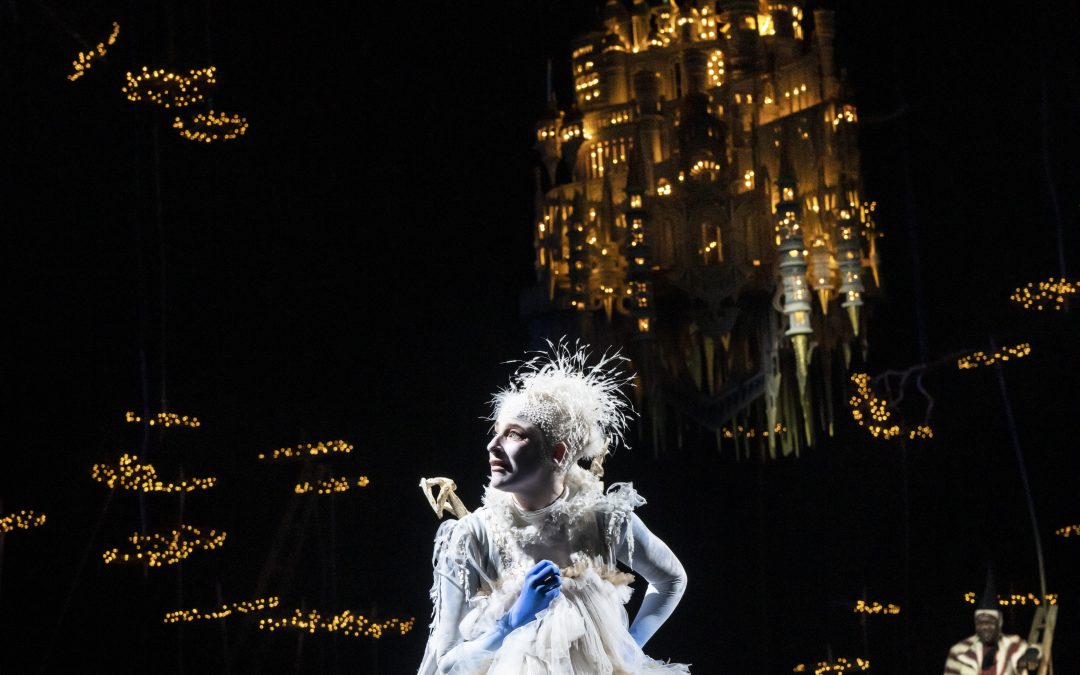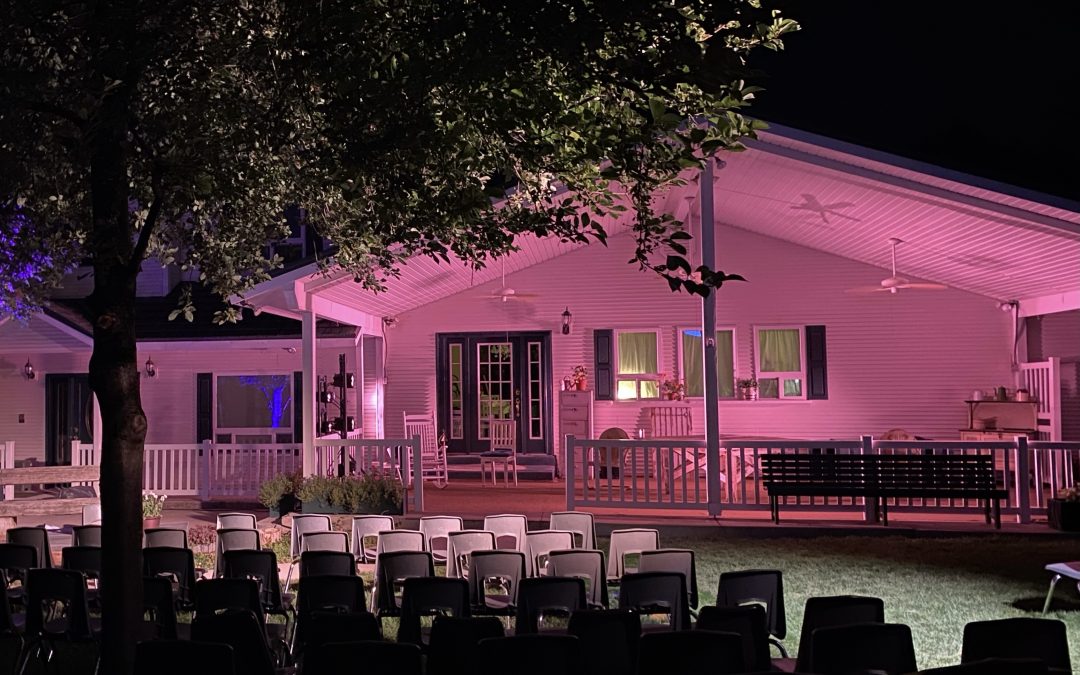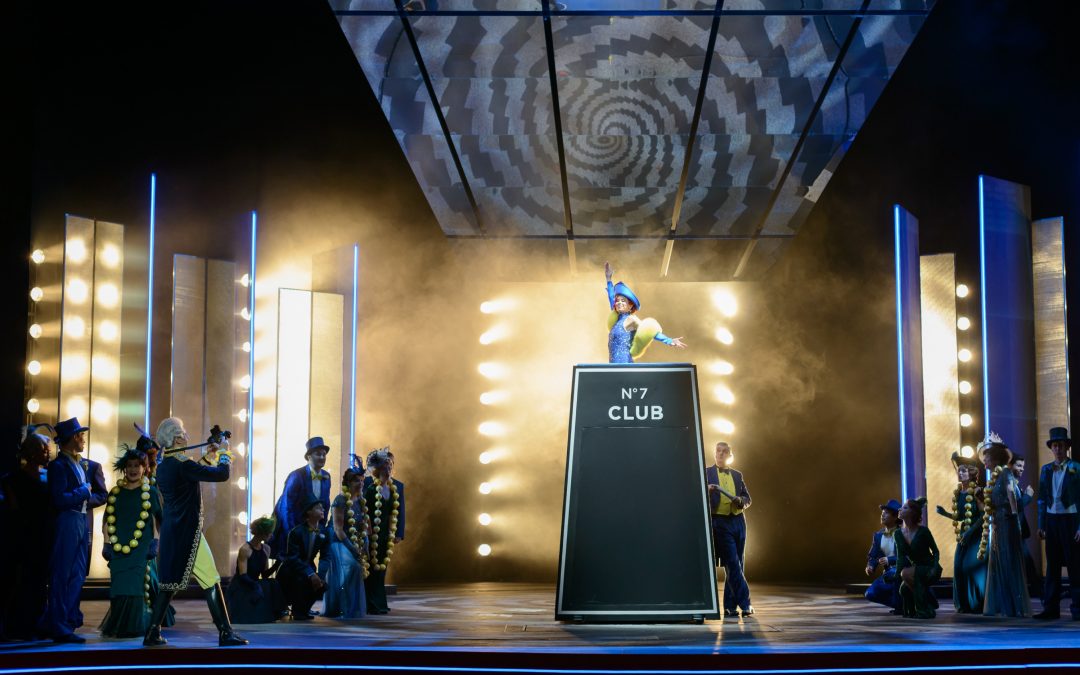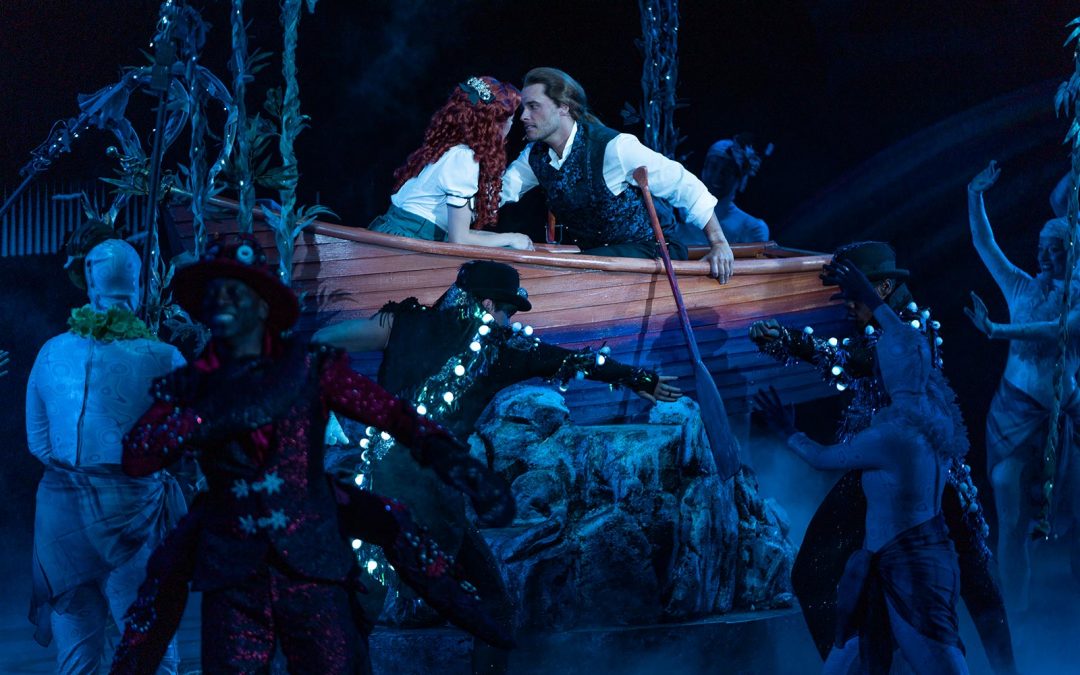
by Aimee Wilson | Oct 31, 2022
For those on the American side of the Atlantic, the National Theatre in London, UK is THE most prestigious theatrical venue. Founded by the legendary Sir Lawrence Olivier in 1963, it comprises several venues: the Olivier Theatre, the Lyttleton Theatre, and the smallest venue, the Dorfman Theatre. They are also home to Lighting Technician Alex Varlow, who happens to have a fondness for wireless dimming and specifically RC4 Wireless. “I first started working with RC4 in 2014, when I began as a freelancer at the National Theatre,” Varlow explains. “Since then, I have worked on countless shows and can only think of a handful which didn’t use RC4. The flexibility, size and reliability make it a powerful tool to be rolled out on almost every show I have worked on here.”
Varlow gave his RC4 Wireless gear a workout on two recent shows: ‘Hex’, based on Sleeping Beauty and a modern version of ‘Much Ado About Nothing’. Varlow notes, “‘Hex’ was our post-COVID Christmas musical in the Olivier Theatre. My role as Floor Electrician was to design, build and run the set, costume and hand-held practical lighting elements. ‘Much Ado About Nothing’ has recently opened in the Lyttelton Theatre. For this production, I was Assistant Lighting Supervisor. Similarly to ‘Hex’, the set had a large amount of practical lighting, which I designed and built with our brilliant inhouse props team. ”
First, the wireless aspects of ‘Hex’. “Being based around Sleeping Beauty, we knew early in the design process that there was going to be a castle,” Varlow notes. “As the show and design concept grew, we found out that the castle was going to be a flown element, housing a performer that would both track up and down stage and rotate 360 degrees. This meant we couldn’t safely get power or data cables run to it; the castle would have to be wireless. We also had a very strict weight limit, so multiple drivers and excessive cabling was not an option.”
Paul Anderson, the Lighting Designer for ‘Hex’, had another requirement as well: the castle had to be able to change color; Varlow had a solution: the RC4Magic S3 DMXpix Dual Pixel String Driver. “We chose pixel tape to give us added control but being a large set piece, it required over ten metres of product,” reports Varlow. There was only one slight problem. “This would quickly eat up addresses on the Olivier’s dedicated wireless universe.”
As Varlow and many others in the lighting world have discovered, RC4 equipment is not only reliable, but versatile. Varlow continues: “We used RC4s powerful keyframe tool to allow us to control the ten metres of tape in one universe. This gave us the ability to add texture and other interesting color effects to the castle without requiring multiple universes of data.” As for the rest of the production, “The ‘Hex’ castle featured twenty-five channels of fairy lights, Gantom spots and other LED tape hidden inside, all receiving data via an RC4Magic DMXio and functioning without a hitch; in total, we had another fifteen DIM2s controlling various lanterns, costume lighting and smoke effects, running multiple universes on separate IDs simultaneously,” he notes.
When technical issues came up during ‘Hex’, Varlow turned to RC4 customer support. He continues: “We were using a new string of pixel tape which was controlled by a protocol not yet implemented into RC4. James [James D. Smith, CEO and chief product developer] was eager to get his hands on a segment, so we FedExed a segment of the tape to him across the pond. Within a few days, James had mapped out the framework for a TM1814 protocol and sent us a firmware update allowing us to light the ‘Hex’ castle. James’ communication and commitment to solving any issues are second to none. No matter how time consuming or complex, I’ve not managed to stump him just yet.”
While Varlow had to deal with the castle in ‘Hex’, he had a different issue in the modern version of ‘Much Ado About Nothing’. He explains, “Our biggest challenge on Much Ado, from a practical standpoint, was a pair of Art Deco elevator floor indicators, present in the fictional hotel the show takes place within. In early meetings, our Lighting Designer, Lucy Carter, asked for each segment of a floor number light box to illuminate, indicating which floor the elevator was on. She also requested a motorized arrow, which followed the lift’s journey through the numbered floors. The prop was quite small in size and attached to a ceiling inside a revolve. This meant it would not be possible to get data, decoders and cabling to these practicals.”
Once again, Varlow turned to RC4 Wireless products for a solution. “We chose to use a RC4 DMXpix to control pixel tape for the lit floor numbers. Using the keystone tool again, I was able to group the pixels together to make each floor number an individual four-channel RGBW lightbox. To control the arrow, we used a DIM2 running in servo controller mode. This allowed our programmer to accurately select a floor controlling the 180-degree movement as an intensity control,” Varlow explains.
The RC4 Wireless DMXpix and DMXio aren’t the only wireless products from the firm at the National Theatre. Varlow notes, ”We have over seventy RC4 products here at the National, and we are always looking to grow our stock and test their new products. James and his team have offered outstanding support, helping us with any issues we run into; they have the outside-the-box thinking vital for creating products that we find so useful.”
“Flexibility is key to RC4’s success in a theatrical environment,” Varlow states. “Being able to be powered over a wide range of voltages makes them adaptable to many low voltage electrical systems. They are compact and so easily hidden in smaller props, such as lanterns and costumes. Their many different curves and control modes give us the chance to create some really special effects. We’ve hidden IO receivers in large LED walls, installed DIM4s in delicate LED-filled costumes and used DIM2s set as a relay to fire smoke effects. I’m sure we haven’t found all their useful applications… yet,” he concludes.
RC4 Wireless is pleased to support the National Theatre through our UK Partner, Lamp and Pencil. They can be reached at http://lampandpencil.com/contact/.
Hex
A new musical based on Sleeping Beauty : book by Tanya Ronder, music by Jim Fortune and lyrics by Rufus Norris
Director : Rufus Norris
Set and Costume Designer : Katrina Lindsay
Choreographer : Jade Hackett
Music Supervision & Vocal Arrangements : Marc Tritschler
Orchestrations : Simon Hale
Music Director : Tarek Merchant
Lighting Designer : Paul Anderson
Sound Designer : Simon Baker
Consultant Choreographer : Bill Deamer
Associate Choreographer : Bradley Charles
Associate Music Director : Cat Beveridge
Staff Director : Seimi Campbell
Ensemble : Christopher Akrill
Bruiser Thorn : Delroy Atkinson
Ensemble : Esme Bacalla-Hayes
Queenie : Tamsin Carroll
Ensemble : Madeline Charlemagne
Ensemble : Ebony Clarke
Fairy : Rosalie Craig
Ensemble : Sonya Cullingford
Ensemble : Hanna Dimtsu
Ensemble : Tamsin Dowsett
Bert : Michael Elcock
Ensemble : Joe Foster
Ensemble : Ben Goffe
Prince : Eleanor Kane
Queen Regina : Daisy Maywood
Ensemble : Kody Mortimer
Ensemble : Joseph Prouse
Rose : Kat Ronney
King/Prince : Shaq Taylor
Smith : Sargon Yelda

by Aimee Wilson | Sep 1, 2022
‘The Tender Land’, with music by Aaron Copland and libretto by Horace Everett, is a story about how one night can change the life of a single person. Set on a farm during the depression, it was the choice for an outdoor performance – at a farmhouse – by the Utah Festival Opera & Musical Theater (UFOMT). “The idea is that you can find love in one night, but surprisingly, the pair doesn’t end up getting together; the girl ends up leaving on her own, and moves on from the farm and her family,” notes Lighting Designer and Head Electrician Jordyn Cozart. “It was a very interesting project; I had never done outdoor theater as a designer before, so it was challenging,” she adds.
The opera was performed on the front porch, and Cozart’s console was in the backyard of the residence located in Millville, Utah. “People were entering and exiting from the house, which is where the RC4 gear comes in,” Cozart notes. “At the end of graduation party, as they’re going inside, the director wanted to be able to make it look like, the lights of the house turn off like they’re going to bed.” After that, she adds, “There is a moment where the main character is up in the window of her bedroom, and the love interest is throwing a rock at the window. She wanted to have a light on in the window so we could see that moment happening inside the house as well. I did not want to rely on actors to turn on and off lights, plus the color temperature of this very modern house would not be the same as it would have been in the 1930s during the depression ”
Cozart fabricated two custom lanterns as a solution. She explains, “I put six volt LED tape in lanterns that I found in the prop shop and then used the RC4 equipment to control it from out in the lawn where the board was. There were two lanterns; there was one in the kitchen and one in the bedroom window.”
Because of the location, she chose to use the RC4Magic-900SX series of products, which uses the 900MHz bandwidth, ensuring superior wireless signal strength. “Each of the lanterns was controlled by an RC4Magic-900SX DMX4dim. The transmitter I used was the 900MHz because I knew that it would be able to go through the walls of the house, and that was my biggest concern since I was operating this from an Ion console literally in the back of the yard behind a porch swing,” notes Cozart.
There was another challenge involved as well. Cozart continues: “The lanterns were a last-minute add, and having the RC4 equipment and knowing I could rely on it and knowing it would work was very nice. It could have been a stressful addition to the production, but it ended up being something I did in 20 minutes: I just soldered a connector on the end of the LED tape, and it was ready to go.”
Cozart, a grad student, spent the summer at the Eccles Theater, the home of UFOMT. “I was the head electrician for the whole season, and this is my first time working with RC4 equipment. ‘The Tender Land’ was our last show to open, so I had been working with it for two months before I used it on that show. By that time, I was familiar with Commander [RC4’s proprietary software], which was nice. If you have basic wiring knowledge, all you have to do is plug it in and it works. That’s simplifying a bit, but it is super reliable,” she says.
For those unfamiliar with RC4, Cozart notes: “I think the concept of wireless DMX seems very daunting at first. When I first got here and realized that all the practicals I was using were wirelessly operated, I was very nervous about it. But honestly, RC4 has made it very easy; it isn’t as scary as you think it is going to be, and it does make doing practicals much easier.”
Cozart is moving onto the theater department at UNLV; she’s not sure of their current wireless DMX situation. “I have full intention of continuing to do more with wireless dmx, and working with RC4. They make wireless so much less scary,” she concludes.

by Aimee Wilson | Jun 28, 2022
Volksoper Wien (Vienna People’s Opera) is a historic opera house built in 1898 and is home to a variety of operas, operettas, ballets and musicals. Earlier this year, they performed the Kurt Weill classic Lady in the Dark. The musical tells the story of Liza Elliott, the editor of Allure magazine and her psychological issue with indecision. She is torn – not between two lovers, but three – all of which want to marry her. For a solution, Liza starts treatment with Dr. Brooks, a psychoanalyst, and they work through her issues by analyzing her dreams. “The set design relied on four wagons equipped with rotating L-shaped walls; they were up to 6 meters high; they created, widened and modulated the space,” notes lighting and networking engineer Christian Allabauer of Volksoper Wien GmbH. Lady in the Dark opened there in late 2021; the lighting design for Lady in the Dark was done by Michael Grundner.
Liz’s dreams take center stage during the performance; one dream takes place in a glamour setting, another is during a wedding, and the third takes place at a circus that includes a trial. “The transition along the glamour, wedding and circus dreams were pronounced by color-tunable LED tubes, fitted along the edges of the walls. Six wheeled archways were equipped with blue LED tubes, opening the world to the ‘blue dream,’ and supporting its choreography,” Allabauer adds.
Due to the nature of the scenic wagons, Volksoper required a wireless solution for the LED tubes. “To achieve the required flexibility, wireless control was a must-have,” he admits. “The compact design required metal framework; there was a lot of traffic on stage, and little space to fit electronics made us consider the locations of receivers very carefully.”
To control the LED tubes, Volksoper Wien turned to RC4 Wireless. “’Lady in the Dark’ was our first production running RC4; we appreciate the small form factor combined with a high-power rating,” he notes.
The RC4 Wireless W-DIM4 four-channel wireless high-power dimmer was Volksoper’s choice for Lady in the Dark. “The W-DIM4 became one of our most frequently used tools, as wireless stage lighting elements are requested again and again by leading teams. Fifteen amps per channel in such a small housing is amazing!” says the lighting and network engineer.
In terms of programming the W-DIM4, he says, “It’s very easy and intuitive! Dimming curves and the capability to dim tungsten lamps as well are quite helpful.” For RC4 Wireless users in Europe, he adds, “You need to get a special tool to crimp the connectors; Anderson connectors are not easy to find in Europe. Order some additional connectors to use the units for several productions.”
RC4 Wireless also provides customer service via phone and email which Allabauer utilized during the production. “We really appreciated the great and instant service,” he says.
Lady in the Dark concluded its run in early 2022. Their 2022/2023 season includes La Cage aux Folles, Into the Woods, and the ballet Begegnungen; Volksoper is using the W-DIM4 in the second act of the ballet. RC4 Wireless technology is also part of Death in Venice, a co-production with the Royal Opera House Covent Garden. Allabauer concludes, “The RC4 W-DIM4s just worked reliably and were an important factor in getting the job done.”

by Aimee Wilson | Jun 2, 2022
At RC4 Wireless, every project starts with a customer’s captivating idea. Back in 2014, that call came from Ciro Scotto d’Antuono from Strictly FX, who had been commissioned to build a series of wirelessly controlled lanterns for World Wrestling Entertainment (WWE). WWE character Bray Wyatt carries what appears to be an antique gas lantern onto the stage in every performance. Ciro was in the process of building a new brighter lantern with a built-in Look Solution Tiny Fogger, all controlled from the show’s primary DMX console.
Strictly FX has used RC4Magic dimmers many times in the past and trusted them for this high-profile job. In this application there was very little space for the fogger, battery, and wireless dimming technology — a perfect job for the miniature RC4Magic Series 3 DMX2micro. The Series 3 DMX2micro is full featured, just like all the other Series 3 versatile wireless dimmers from RC4, and measures only 71mm x 18.8mm x 11mm. It is the smallest wireless DMX receiver and dimmer in the world, perfect for this application.
WWE tours the world, performing in a different location every night. RC4Magic unique digital IDs ensure that whatever arena they are located in, they never have to worry about interference from any other RC4Magic system.
“When I see Bray Wyatt walk into the arena holding that lantern, then watch him make his way to the center and into the ring while it is glowing and emitting smoke that is controlled from the front of house, I feel great knowing we have helped WWE and Strictly FX Live Life Untethered,” says Sean Dane, RC4 Wireless Application Specialist.

by boss | Mar 31, 2020
In the year 1836, the magical story of a mermaid and a king leapt out of the imagination of Hans Christian Anderson and became the beloved tale of “The Little Mermaid”. In the 150 plus years since then, the iconic, magical story – with the help of two Disney films – has become something of a phenomenon.
When the Tuacahn Center for the Arts, based in Ivins, Utah, decided to present their take on this theatrical classic, they turned to RC4 Wireless to create some magic all over the stage, which include costumes, set pieces and even props. “For pixel control of the Flotsam and Jetsam costumes we used a DMXpix — one for each piece. We used them with pixel domes, which are individually controllable pixels, but spaced out and capped with a plastic ‘dome’ to diffuse the light,” explains Adam Manning, Assistant Master Electrician at the Tuacahn. Manning wasn’t working alone on the project; the team also included Lighting Designer Nick Van Houten of NVH Design, Costume Designer Dustin Cross and Scenic Designer Adam Koch.
The illuminated costumes of Flotsam and Jetsam weren’t the only pieces using the DMXpix. It was also used in King Triton’s trident. Manning notes: “The DMXpix inside the trident provided approximately 4.5A – or 22.5W – for the pixel tape.” The DMXpix is a pixel driver that can control a large number of pixels without a media server, and was the winner of a PLASA Award for Innovation when it was introduced. “The principle of the DMXpix is to move pattern repetition out of the lighting console and over to the pixel controller. The look of the pattern, what we call the Keyframe, is created on the console using a select number of channels, then the DMXpix does the job of replicating that pattern in a variety of user-configurable ways to control up to 500 pixels,” explains James David Smith, Founder and Chief Product Designer at RC4. “And, a single DMXpix can do all of that twice — it’s actually two drivers in one, each with its own Keyframe.” The RC4Magic DMXpix is available in the popular 2.4GHz range for use worldwide and in the much less congested 902-928MHz band in the US, Canada, Australia, and New Zealand.
In terms of The Little Mermaid set, there was wirelessly controlled lighting in nine set pieces including “Two castle towers, Ursula’s shell, two King Triton towers and Ursula’s cauldron,” explains Manning. In terms of gear, “We used an RC4 MagicDMX4dim for each set piece to drive the LEDs on each unit,” explains Manning. The RC4 Wireless DMX4dim is one of the firm’s most popular products; it’s also the wireless workhorse at the Tuacahn. “We use the DMX4dim for everything,” states Craig Engel, production manager at the Tuacahn. The DMX4dim is a 4-channel dimmer, also available in both 2.4GHz and 900MHz, and works with an RC4 DMXio Transceiver to control lighting—as well as servo motors, and much more—wirelessly. Manning continues: “For me, using the system to create magical wireless effects has been the go-to. The setup of the system is very simple and doesn’t take very long to do. Once the system is set up, it doesn’t take much to keep it working.” The system can be set-up manually with buttons and indicators on each unit or via RC4 Commander Configuration Software. “One thing I’m super proud of is that our new Commander software is backward compatible with most of our Series 2 devices, so it works with a mix of devices going all the way back to 2011. It is Series, Model, and firmware-version aware, so what you see is accurately what you get when viewing and setting parameters on screen,” explains Smith.
As with all wireless units, placement is key. “We build our set pieces with a steel frame, so keeping a clear line-of-sight from the transmitters to the receivers is critical for consistent operation. As long as the units are enclosed in a material which is transparent to radio waves, keeping a clear connection isn’t an issue,” says Manning.
Manning has been working with RC4 Wireless equipment for the past three years. “Once the system is set up, it just works. Of course, I do have to make the rare call for troubleshooting help. When I have called customer support, they have been very helpful at providing quick and effective solutions. They are very knowledgeable about the hardware and can provide answers to any questions quickly,” says Manning.
Engel has been working with RC4 gear even longer. “I have been associated with the theater for 10 years and RC4 has been the wireless system in use. They have the absolute best customer support bar none of any vendor I deal with and their equipment is super reliable and innovative,” Engel concludes.




